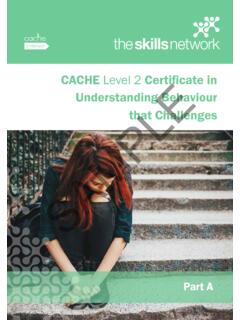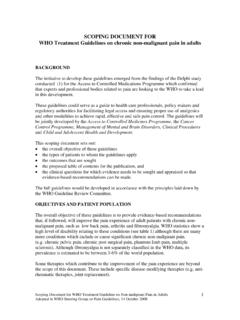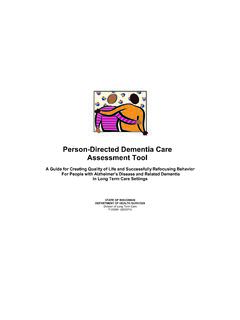Transcription of CACHE Level 2 Certificate in Understanding Behaviour that ...
1 Part ACACHE Level 2 Certificate in Understanding Behaviour that Challenges SAMPLED isclaimer:This resource uses real life case studies where specifically stated and referenced. All other references to individuals, groups and companies contained within these resources are fictitious. Disclaimer statement: CACHE is a trading name of NCFE (registered company 02896700) and CACHE ; Council for Awards in Care, Health and Education; and NNEB are registered trademarks owned by NCFE. CACHE has exercised reasonable care and skill in endorsing this resource, and makes no representation, express or implied, with regard to the continued accuracy of the information contained in this resource. CACHE does not accept any responsibility or liability for any errors or omissions from the resource or the consequences statement: CACHE is the trading name of NCFE (registered company 02896700) and CACHE ; Council for Awards in Care, Health and Education; and NNEB are registered trademarks owned by NCFE.
2 This learning resource is endorsed by CACHE against the associated NCFE CACHE qualification/unit(s); this means that CACHE has reviewed the resource and agreed it meets the endorsement Behaviour that Challenges Introduction1 Certificate in Understanding Behaviour that Challenges Welcome to this Level 2 Certificate in Understanding Behaviour that you start to read through each page, you will be able to make notes and comments on things you have learnt or may want to revisit at a later stage. At the end of each section, you will be asked to answer the relevant assessment questions. Once you have answered the questions, go to the next section and continue studying until all of the assessment questions have been make sure that you set aside enough time to read each section carefully, making notes and completing all of the activities. This will allow you to gain a better Understanding of the subject content, and will help you to answer all of the assessment questions luck with your study.
3 Now let s begin!We hope you find all of the information contained in this resource pack interesting and informative. This learning resource and the assessment questions have been approved by CACHE as a great way to meet the learning outcomes for this qualification. (A complete list of the learning outcomes can be found at the back of this workbook.) This course is made up of two parts (A and B). This is Part A , which contains two units:Unit 1: Understand Behaviour that challenges Unit 2: Understand how to support positive behaviourSAMPLE2 Understanding Behaviour that Challenges Unit 1: Understand Behaviour that challengesWelcome to Unit unit is split into three sections. These are: Section 1: Behaviour that challengesSection 2: The reasons why people present with Behaviour that is perceived as challengingSection 3: The impact of Behaviour that challengesSAMPLE3 Understanding Behaviour that Challenges What is meant by the terms Behaviour that challenges and positive Behaviour Section 1: Behaviour that challengesThis section will explore the following: What is meant by the terms Behaviour that challenges and positive Behaviour Behaviours that may be perceived as challenging The difference between conflict and Behaviour that challenges The difference between aggression and assertive Behaviour .
4 STOP AND THINK!Take some time to think about the ideas that you already have about Behaviour that challenges and positive Behaviour . What do these two terms mean to you? Note down your thoughts in the space below.!SAMPLE4 Understanding Behaviour that Challenges The term Behaviour that challenges has changed several times over the years, previously being referred to as: Challenging Behaviour Problem Behaviour Difficult Behaviour Socially unacceptable of the above terms are unacceptable, as they are believed to place a negative label on the individual. Such terms define the individual in terms of their Behaviour , at the expense of all other aspects of who they are, and are seen as judgemental. When a person such as a member of staff speaks in a judgemental way about someone, their actions tend to match this, and the Behaviour of the individual may deteriorate in response to this. Behaviour that challenges should not be seen as a diagnosis, but instead as something that is being done in order to serve a purpose, such as communicating an unmet need or attempting to interact with another person.
5 It almost always serves to show that something is not working between the individual and their is considered to be challenging if it poses risk or harm to the individual or to others and leads them to have a poorer quality of life. For example, Behaviour that challenges may mean that an individual cannot: Attend school as they have shown consistent aggression towardsa member of staff Go on an outing as they are at risk of running off Eat using proper cutlery and crockery as they use these to injure themselves Visit anyone else s home as they at risk of destroying who are most likely to present with Behaviour that challenges include individuals with: Learning disabilities dementia Some mental illnesses such as schizophrenia Sensory that challengesSAMPLE5 Understanding Behaviour that Challenges Key FactBehaviour that challenges is thought to be highest among people with learning disabilities in a hospital setting, where the prevalence rate is 30 40% of people who are treated.
6 And-interventions-for-people-with-learni ng-disabilities-whose- Behaviour -challenges-1837266392005 Individuals who present with Behaviour that challenges should not be seen as a problem to others and as someone who needs to be fixed , but simply as someone who is trying to interact with others. All Behaviour has a meaning and a purpose that are unique to each individual, which is exactly how Behaviour that challenges should be perceived. Behaviour that challenges is not something that is defined in precisely the same way by everyone and perceived as the same in every setting. For example, if someone who has autism were to repeatedly bang their head on a wall at home, this would indicate to their parents that they had an unmet need; they know how to work with the individual and the Behaviour would not be perceived as challenging. However, if the individual were to behave in the same way whilst in a restaurant or other social setting, the reaction to this Behaviour would likely be very different by the people who witnessed it.
7 Therefore, it is important to keep in mind that the way in which people perceive Behaviour that challenges may change and may be interpreted in different ways by people who encounter it. It is crucial to ensure that the Behaviour is interpreted correctly and that the individual s quality of life remains as high as Behaviour that Challenges Activity 1: Individuals needsTry to think of at least two examples of each type of need below that an individual may have. You can use yourself as an example whilst completing this ) Physicalb) Emotionalc) PsychologicalAPositive behaviourPositive Behaviour involves both words and actions, which ensure that the well-being and dignity of the individual and those around them are Behaviour ensures that an individual s needs are met in many different aspects of their lives, such as: Physically Emotionally Psychologically Spiritually Intellectually Socially. SAMPLE7 Understanding Behaviour that Challenges d) Spirituale) Intellectualf) SocialEnsuring that needs are met in a holistic way will help to reduce the opportunities for Behaviour that challenges because unmet needs are thought to be one of the most common reasons why an individual presents with this kind of Behaviour .
8 Definition: Holistic Taking into account the whole person, rather than just a single aspect of what makes them who they are. DMany settings now use what is known as positive Behaviour support. This is a strategy that attempts to understand why an individual presents with certain behaviours and what the triggers of these behaviours might be. This kind of support is based on recognising the fact that every person is a unique individual whose human rights should be acted upon, including accepting that behaviours that challenge can actually serve an important function in enabling people to live in a way that is meaningful to them. SAMPLE8 Understanding Behaviour that Challenges Further Research: Positive Behaviour support Download the document from the following link and make any notes that you think may be useful to you in your setting. The document contains information on positive Behaviour support and how this can be applied when care planning takes Activity 2: Positive Behaviour in your settingThink about the types of positive Behaviour that you see in your setting.
9 Try to provide three examples that demonstrate how the dignity of the people with whom you work is maintained and respected. If you do not currently work in a setting where it is possible for you to do this, think of three examples that you would expect to Behaviour that Challenges Behaviour that challenges can manifest itself differently depending on who is presenting with it. For example, it might be: Passive aggressive: this type of Behaviour is often harder to detect than active aggressive Behaviour , as it is sometimes unobservable. It refers to how individuals may be resistant to orders and may avoid direct types of confrontation. It may be more common in individuals who have issues with some forms of social interaction, as it often means that they will not let others know how they are feeling, possibly because they do not want to or do not have the capacity to. Instead, they present with negative behaviours such as giving angry looks, not speaking to someone or being obstructive in their attitude.
10 Active aggressive: this type of aggression is usually what comes to mind when people think about Behaviour that challenges. It is characterised by clearly observable behaviours, which are often used to intimidate or harass people, but sometimes are simply a way in which an individual tries to express passive and active aggression can be seen in three different ways:1. Verbally2. Non-verbally3. order to understand what Behaviour that challenges actually involves, it is important to be aware of different examples of each of these types of that may be perceived as challengingSAMPLE10 Understanding Behaviour that Challenges Verbal behaviourExamples of verbal behaviours that challenge include: Shouting Arguing Screaming Abuse, including use of offensive language Threatening Use of inappropriate terms , such as those that are sexist or racist behaviourExamples of non-verbal behaviours that challenge include: Giving rude looks and other negative facial expressions Being deliberately silent Walking away when being spoken to Clenching fists Standing in someone s personal space Pointing in someone s face Standing in an aggressive posture.








